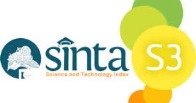PEMANFAATAN ISU SOSIO-SAINTIFIK TRADISI MENGINANG SEBAGAI KONTEKS BELAJAR IPA SMP
(1) UniversitasTidar
(*) Corresponding Author
Abstract
Keywords
Full Text:
PDFReferences
Auluck, A., Hislop, G., Poh, C., Zhang, L., & Rosin, M. P. (2009). Areca nut and betel quid chewing among South Asian immigrants to Western countries and its implications for oral cancer screening. Rural and remote health, 9(2), 1118.
Chiappetta, E. L. & Koballa, T. R. Jr. (2010). Science instruction in the middle and secondary schoo (7th ed.). New York: Pearson Education, Inc.
Evagorou, M., Albe, V., Angelides, P., Couso, D., Chirlesan, G., Evans, R. H., ... & Nielsen, J. A. (2014). Preparing pre-service science teachers to teach socio-scientific (SSI) argumentation. Science Teacher Education, 69(39-48).
Evagorou, M., Jimenez-Aleixandre, M. P., & Osborne, J. (2012). ‘Should we kill the grey squirrels?’A study exploring students’ justifications and decision-making. International Journal of Science Education, 34(3), 401-428.
Fathiazad, F., Delazar, A., Amiri, R., & Sarker, S. D. (2010). Extraction of flavonoids and quantification of rutin from waste tobacco leaves. Iranian Journal of Pharmaceutical Research, 222-227.
Flora, M. S., Mascie-Taylor, C. G. N., & Rahman, M. (2012). Betel quid chewing and its risk factors in Bangladeshi adults. WHO South-East Asia Journal of Public Health, 169.
Iptika, A. (2014). Keterkaitan kebiasaan dan kepercayaan mengunyah sirih Pinang dengan kesehatan gigi. Jurnal Masyarakat, Kebudayaan dan Politik, 3, 64-69.
Khalisa, E., Adhani, R., & Arifin, S. (2016). Hubungan kebiasaan merokok dengan pembentukan stain (noda gigi) pada pasien di poli gigi RSUD Ratu Zalecha Martapura. Dentino, 1(1), 27-31.
Lederman, N. G., Lederman, J. S., & Antink, A. (2013). Nature of science and scientific inquiry as contexts for the learning of science and achievement of scientific literacy. International Journal of Education in Mathematics, Science and Technology, 1(3).
Pambayun, R., Gardjito, M., Sudarmadji, S., & Rahayu, K. (2008). Sensitivity of gram positive bacteria in catechins extracted from gambier (Uncaria Gambir [Roxb.]). Agritech, 28/4, 174-179.
Rahayu, Sri. 2014. Revitalisasi Scientific Approach dalam Kurikulum 2013 untuk Meningkatkan Literasi Sains: Tantangan dan Harapan. Seminar Nasional Kimia dan Pembelajarannya 2014.
Rahayu, S. (2015). Meningkatkan Profesionalisme Guru dalam Mewujudkan Literasi Sains Siswa melalui Pembelajaran Kimia/IPA Berkonteks Isu-Isu Sosiosaintifik (Socioscientific Issues). Keynote paper disampaikan dalam Semnas Pendidikan Kimia & Sains Kimia di Fakultas Pendidikan MIPA FKIP Universitas Negeri Cendana, 8.
Ridzuan, N. B. (2009). Kanker rongga mulut disebabkan oleh kebiasaan menyirih. Medan: Skripsi. FakultasKedokteran Gigi Universitas Sumatera Utara.
Rizkita, A. D., Cahyono, E., & Mursiti, S. (2017). Isolasi dan Uji Antibakteri Minyak Daun Sirih Hijau dan Merah Terhadap Streptococcus mutans. Indonesian Journal of Chemical Science, 6/3, 279-286.
Rooney, D. F. (1995). Betel Chewing in South-East Asia. centre National de la Recherche Scientifique (CNRS). Lyon.
Shah, G., Chaturvedi, P., & Vaishampayan, S. (2012). Arecanut as an emerging etiology of oral cancers in India. Indian journal of medical and paediatric oncology: official journal of Indian Society of Medical & Paediatric Oncology, 33(2), 71.
Siqueira, J. F. (2001). Strategies to treat infected root canals. CDA, 29(12), 825-838.
Zeidler, D. L., & Nichols, B. H. (2009). Socioscientific issues: Theory and practice. Journal of Elementary Science Education, 21(2), 49.
Article Metrics
Abstract view : 1011 timesPDF - 134 times
DOI: https://doi.org/10.26714/jps.7.2.2019.123-128
Refbacks
- There are currently no refbacks.
Copyright (c) 2019 JURNAL PENDIDIKAN SAINS (JPS)

This work is licensed under a Creative Commons Attribution 4.0 International License.
EXECUTIVE OFFICE
JURNAL PENDIDIKAN SAINS UNIVERSITAS MUHAMMADIYAH SEMARANG
DEPARTMENT OF CHEMISTRY EDUCATION
FACULTY OF MATHEMATICS AND NATURAL SCIENCES
MUHAMMADIYAH SEMARANG UNIVERSITY
Jl. Kedungmundu Raya No.18, Semarang, Jawa Tengah, Indonesia
Telp. (024)76740231, 76740231
email: jps@unimus.ac.id

This work is licensed under a Creative Commons Attribution 4.0 International License
Journal Pendidikan Saisn (JPS)
ISSN:2339-0786, e-ISSN:2502-1443
Published by: Chemistry Education, Muhammadiyah Semarang University










